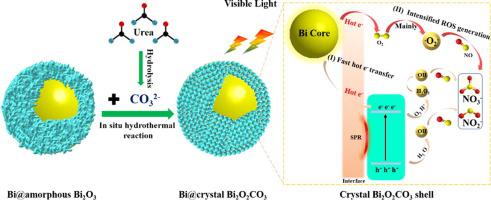Chemical Engineering Journal ( IF 13.3 ) Pub Date : 2021-04-24 , DOI: 10.1016/j.cej.2021.129814
Peng Zhang , Yongfang Rao , Yu Huang , Meijuan Chen , Tingting Huang , Wingkei Ho , Shuncheng Lee , Junbo Zhong , Junji Cao

|
The inevitable amorphous Bi2O3 on the surface of plasmonic Bi nanospheres serving as the recombination center of hot electron-hole pairs, hindered the transfer of photo-generated hot electrons and production of reactive oxygen species (ROS) seriously. In this study, Bi@amorphous Bi2O3 was transformed to Bi@crystal Bi2O2CO3 by secondary hydrothermal reaction. Bi@Bi2O2CO3 core-shell photocatalyst exhibited higher visible-light catalytic activity (34.1%) than Bi@Bi2O3 did (12.3%) in terms of NOx removal. Photoelectrochemical, surface photovoltage spectroscopy spectra and Kelvin probe force microscopy measurement results indicate that Bi2O2CO3 shell reduced the transmission resistance of hot electrons excited from Bi core. O2-TPD, trapping experiments and density functional theory further confirmed that the transferred hot electrons were a help for ROS generation and •O2− radicals were the major contributor. This study not only addresses the unsettled issue of surface amorphous Bi2O3, but also provides a facile method to transform the amorphous shell to crystal phase of core-shell photocatalyst and new insights into the hot electrons separation and the formation of main ROS over the surface crystal transition of plasmonic Bi.
中文翻译:

无定形的Bi转变2 ö 3晶体的Bi 2 ö 2 CO 3上铋纳米球表面,用于光催化NO X的氧化:强化热电子转移和活性氧产生
作为热电子-空穴对的复合中心的等离激元Bi纳米球表面不可避免的非晶态Bi 2 O 3严重阻碍了光生热电子的转移和活性氧(ROS)的产生。在这项研究中,铋@无定形的Bi 2 ö 3转化到毕@晶体的Bi 2 ö 2 CO 3通过二次水热反应。就NO x而言,Bi @ Bi 2 O 2 CO 3核壳光催化剂显示出比Bi @ Bi 2 O 3更高的可见光催化活性(34.1%)(12.3%)移动。光电化学,表面光电压光谱和开尔文探针力显微镜测量结果表明,Bi 2 O 2 CO 3壳层降低了Bi核激发的热电子的传输电阻。Ø 2 -TPD,诱捕实验和密度泛函理论进一步证实了转热电子是活性氧产生和•ø帮助2 -自由基是主要的贡献者。这项研究不仅解决了表面非晶态Bi 2 O 3的未解决问题。,但也提供了一种将非晶态壳转化为核壳型光催化剂晶相的简便方法,并提供了新的见解,以了解热电子的分离以及等离激子Bi的表面晶体跃迁上主要ROS的形成。

































 京公网安备 11010802027423号
京公网安备 11010802027423号